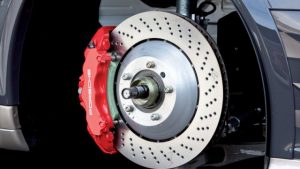Modern cars benefit from technology, which has been honed over decades of competition. Some innovations started with race teams looking for an advantage, others originated outside of racing but proved their effectiveness on track. All these tests and tweaks make cars better.
Here are some race technologies that migrated into our cars:
All-wheel drive
 Although a few road vehicles and race cars existed with four wheel drive before it, the Audi Coupe Quattro was the first with an all-wheel drive system. The Quattro was built to dominate the World Rally Championship. Engineers bet the extra traction of all-wheel drive would be advantageous on the many unpaved, and sometimes snow-covered rally stages. The Quattro proved them right, winning the championship in 1983 and 1984.
Although a few road vehicles and race cars existed with four wheel drive before it, the Audi Coupe Quattro was the first with an all-wheel drive system. The Quattro was built to dominate the World Rally Championship. Engineers bet the extra traction of all-wheel drive would be advantageous on the many unpaved, and sometimes snow-covered rally stages. The Quattro proved them right, winning the championship in 1983 and 1984.
Meanwhile, the WRC embraced all-wheel drive and never looked back, paving the way for cars like the Subaru Impreza WRX and Mitsubishi Lancer Evolution. The biggest advantage of all-wheel drive systems is their superior traction but sports cars take advantage of the additional traction even on dry surfaces to achieve faster acceleration times.
Turbocharging

Turbocharging didn’t start in race cars, but Turbocharged cars didn’t make much of an impact until they went racing. This began in earnest in the 1970s, when Porsche launched its 917/10 and 917/30 Can-Am cars, and Renault brought turbo power to Formula One. It was that era of racing that paved the way for turbochargers to really go mainstream in road cars. Turbos are still used for performance, but automakers increasingly use them to downsize engines in the name of fuel economy. Turbochargers allow smaller engines to produce more power.
Semi-automatic gearboxes
 Gearboxes used to be a simple choice between manual or automatic, that was before racing teams found a performance advantage in transmissions drivers which can shift themselves without a clutch pedal. Eliminating the clutch allows transmissions to shift faster, so it was only a matter of time before the technology became commonplace in both race cars and road-going sports cars.
Gearboxes used to be a simple choice between manual or automatic, that was before racing teams found a performance advantage in transmissions drivers which can shift themselves without a clutch pedal. Eliminating the clutch allows transmissions to shift faster, so it was only a matter of time before the technology became commonplace in both race cars and road-going sports cars.
Anti-lock brakes
 Anti-lock braking systems (ABS) were used more commonly in aircraft before cars. In 1961, a variation of the system was fitted to the Ferguson P99 Formula One car but this wasn’t very successful in F1. It only won a single race, and driver Stirling Moss didn’t even use the ABS, preferring to modulate the brakes the old-fashioned way.
Anti-lock braking systems (ABS) were used more commonly in aircraft before cars. In 1961, a variation of the system was fitted to the Ferguson P99 Formula One car but this wasn’t very successful in F1. It only won a single race, and driver Stirling Moss didn’t even use the ABS, preferring to modulate the brakes the old-fashioned way.
The Ferguson P99 was ahead of its time. Its ABS was mechanical; it would take electronics to make ABS truly practical. Today, it’s illegal to sell a new car without ABS in the U.S. However, ABS is not allowed in Formula One. It’s one of many driver aids banned in the series.
